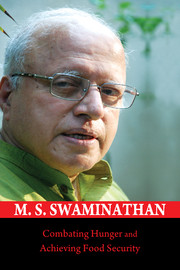Book contents
- Frontmatter
- Contents
- Foreword
- Preface
- Acknowledgements
- Abbreviations
- 1 Genesis and Growth of the Yield Revolution in Wheat
- 2 Our Agricultural Heritage
- 3 Shaping Our Agricultural Destiny
- 4 Thrust on Farm Revival
- 5 Nutri-farm Movement
- 6 Nutrition-sensitive Agriculture
- 7 Food Losses and Food Waste
- 8 Rice in Zero Hunger Challenge
- 9 Monsoon Management
- 10 Importance of Ecological Conservation
- 11 Caring for Ecology and Heritage
- 12 Conserving Biodiversity
- 13 Overcoming Hidden Hunger through Aquaculture
- 14 Biofuels – The Way to Go
- 15 Food Security
- 16 Vigilance for Sustainable Food Security
- 17 Food Security and Social Protection
- 18 Food Security and its Role
- 19 Sustaining the Livestock Revolution
- 20 Challenges in the Year of Science
- 21 Agriculture and Humanism
- 22 Fostering the Science of Science Communication
- 23 Olympic Move for Saving Children
- 24 Youth: The Agents of Change
- 25 Role of Women in Agricultural Production
- 26 Know-how to Do-how
- 27 From Bengal Famine to Right to Food
- 28 Financial Institutions and Fighting Food Inflation
- 29 Public Good Research in Agriculture
- 30 The Future of Indian Agriculture
- Bibliography
12 - Conserving Biodiversity
Published online by Cambridge University Press: 18 December 2015
- Frontmatter
- Contents
- Foreword
- Preface
- Acknowledgements
- Abbreviations
- 1 Genesis and Growth of the Yield Revolution in Wheat
- 2 Our Agricultural Heritage
- 3 Shaping Our Agricultural Destiny
- 4 Thrust on Farm Revival
- 5 Nutri-farm Movement
- 6 Nutrition-sensitive Agriculture
- 7 Food Losses and Food Waste
- 8 Rice in Zero Hunger Challenge
- 9 Monsoon Management
- 10 Importance of Ecological Conservation
- 11 Caring for Ecology and Heritage
- 12 Conserving Biodiversity
- 13 Overcoming Hidden Hunger through Aquaculture
- 14 Biofuels – The Way to Go
- 15 Food Security
- 16 Vigilance for Sustainable Food Security
- 17 Food Security and Social Protection
- 18 Food Security and its Role
- 19 Sustaining the Livestock Revolution
- 20 Challenges in the Year of Science
- 21 Agriculture and Humanism
- 22 Fostering the Science of Science Communication
- 23 Olympic Move for Saving Children
- 24 Youth: The Agents of Change
- 25 Role of Women in Agricultural Production
- 26 Know-how to Do-how
- 27 From Bengal Famine to Right to Food
- 28 Financial Institutions and Fighting Food Inflation
- 29 Public Good Research in Agriculture
- 30 The Future of Indian Agriculture
- Bibliography
Summary
2010 was declared the International Year of Biodiversity by the United Nations General Assembly. For long, in situ conservation of biodiversity through national parks, biosphere reserves, heritage sites and other forms of protected areas, as well as ex situ preservation through botanical and zoological gardens and cryogenic gene banks have received considerable attention.
Such forms of conservation as well as monitoring through Red Data Books (documents established for recording rare and endangered species of animals, plants and fungi as well as some local sub-species that exist within the territory of the state or country) have mostly been undertaken by professionals and publicly-funded organizations. The significant contributions to biodiversity conservation and enhancement by tribal and rural women and men have, however, remained largely unrecognized and unsung. Community conservation methods range from in situ on-farm conservation to ex situ preservation through sacred groves and home gardens.
Community conservation is largely responsible for the existence of numerous landraces in crop plants, as for example, for over 125,000 strains of rice in the world. Fortunately, both the Convention on Biological Diversity (CBD) adopted at the Earth Summit held in Rio de Janeiro in 1992 and the FAO Treaty on Plant Genetic Resources for Food Security (2001) recognize the role of farmers and rural communities in the field of biodiversity conservation and their enrichment through natural and human selection.
The Aichi Biodiversity targets are 20 ambitious goals that make up part of the CBD's Strategic Plan for Biodiversity 2011– 20, adopted in Nagoya, Japan, in 2010. The targets provide a framework for action by all stakeholders – including cities – to save biodiversity and enhance its benefits for people. Two of the targets are of great interest in our context.
• By 2020, the traditional knowledge, innovations and practices of indigenous and local communities relevant for the conservation and sustainable use of biodiversity, and their customary use of biological resources, are respected, subject to national legislation and relevant international obligations, and fully integrated and reflected in the implementation of the Convention with the full and effective participation of indigenous and local communities, at all relevant levels.
• By 2020, knowledge, the science base and technologies related to biodiversity, its values, functioning, status and trends, and the consequences of its loss, are improved, widely shared and transferred, and applied.
- Type
- Chapter
- Information
- Combating Hunger and Achieving Food Security , pp. 69 - 72Publisher: Cambridge University PressPrint publication year: 2016



